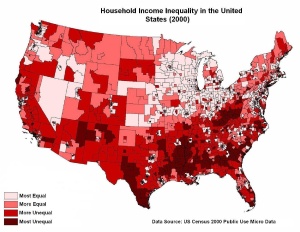Income and wealth distribution is a known inequality in the United States. Both James Cypher and Diana Furchtgott-Roth agree that income inequality is rising but they differ to the extent of this difference and its impact. First off, there are several measurements of income that you should become familiar with when reading about this topic. One is the quintile distribution of income, which is computed by the Census Bureau. In 2007, the highest quintile received about one half of total household income. Here is the link to their website for lots of fun statistics, wohoo! Another measurement is the Gini coefficient/ index ,which ranges from 0 with perfect equality to 1 which represents perfect inequality. For reference, in 2007 the Gini index was at .47.
Economist James Cypher, points out how many heterodox economists look at income and wealth as one of the most important indicators of the overall state of an economy. Cypher believes we are experiencing the largest shift in distribution since the 19th century. He discusses several reasons why income inequality is on the rise. One main reason is the power that wealthy individuals and US corporations have due to the opportunities created by the rapid increase in globalization. He also discusses the government’s role in creating “pro-economic policies” such as NAFTA and tax cuts for corporations and the “frontal assault” on unions. (Please view the youtube video below to further investigae the impact of union busting) Overall Cypher fears that there is nothing to stop the growing inequality among Americans.
Furchtgott-Roth argues that one needs to carefully look at the measures of inequality as the numbers can be distorting. She discusses various reasons for why the stats may not always represent what they say they are. Here are a few examples that she mentions; 1) you need to consider that the tendency of high-income men marrying high-income women, which will increase the inequality among households without actually changing the wealth of the individuals. 2) Measurements under tax policy also create a problem since the tax returns are measured by units (eg: married couple/ family) rather than individuals. Like Cypher, she analyzes the consumption patterns of the rich but comes to a different conclusion- some households in the bottom quintile are not truly poor. She does not believe there is a “surge” in inequality and looks to other factors such as difference in education as a source of inequality. Here is a link to a similar argument about the distortions of census data.
Map of US Income Distribution: The lighter means more equal if you cannot read the legend.

Finally, here is the video I referenced before that talks about the politics of de-unionization has caused income disparity. If you want to save time, start around 2 minutes in.
As always, some questions to consider:
Do you think the government should play a role in moderating the income inequality? If so, what type of market intervention would be beneficial? If not, why do you support a free market?
What did you think about the distortions of census data?
How do previous discussions such as CEO pay, NAFTA, current recession, etc. play into income distribution?



